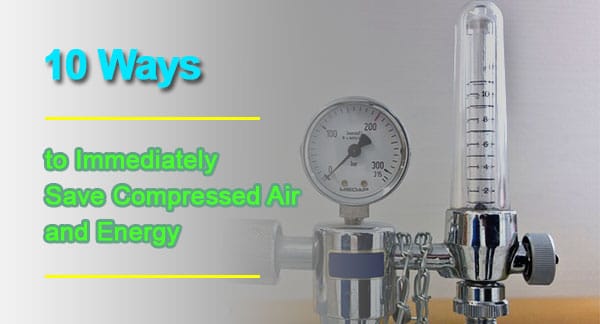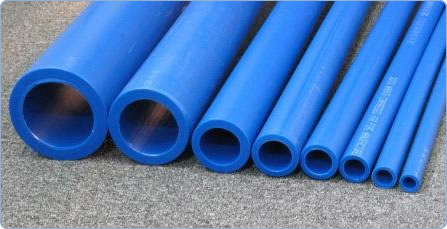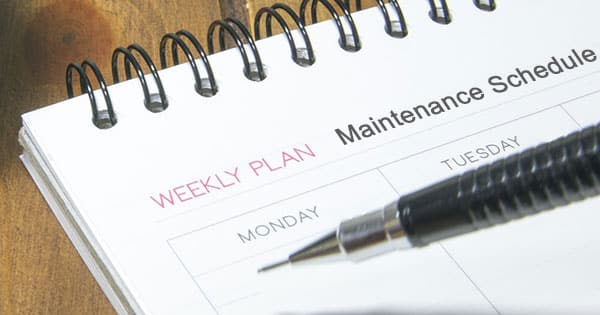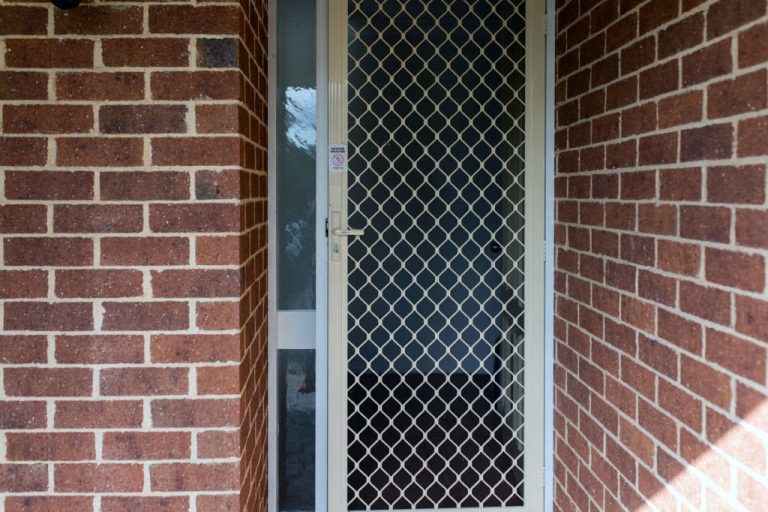10 Ways to save compressed air today!

Compressed air can be costly – so it is important to keep waste at a minimum while taking advantage of the benefits compressed air offers.

A good practice is to measure and monitor your compressed air system, flow rates, operating air pressure and energy consumption. Small adjustments where applicable can reduce your operating costs while improving flow rates and output. Here are 10 things that you can do now to optimize your systems and reduce energy costs!
1.When Not In Use, Turn Off the Compressed Air.
There are 168 hours in a week, but most compressed air systems only run at or near full capacity between 60-100 hours. So depending on your plant’s shift work pattern, you may consider turning off your compressors in the evenings and on weekends. This could reduce your energy bills up to 20 percent! One of the advantages of compressed air is that the energy can be used “on demand” so you can use it only when you need and not when you don’t. For example, if you are using compressed air for any blow off, drying or cooling application and the part being addressed is intermittent, you can install a sensor, PLC or timer and a solenoid valve to turn the compressor on and off as needed. Depending on how intermittently the air is needed, savings can easily add up from anywhere between 5% and 20%. This is an advantage of compressed air that is often overlooked – so when using compressed air, or considering its use against other options, don’t forget to keep the actual cycle time in mind because this can have dramatic impact on the actual costs. You cannot have this instant “demand” with most other options.
2.Find and Fix Existing Leaks in the System.

An air leak that is ¼” can cost you more than $2,500 a year. Imagine a series of smaller leaks that can potentially add up to sizes larger than ¼”. Pipe systems that are older than five years may have leaks of up to 25 percent of produced capacity if left unchecked and unrepaired. It takes energy to generate compressed air, so any air that leaks is essentially money wasted. Yet – air leaks tend to be largely ignored because you cannot “see it”. But if you have a water leak it is readily visible and often quickly addressed. Yet the cost of a compressed air leak can be much higher. Approximately 80 percent of air leaks are not audible so one means to detect (and then repair) leaks is to regularly check for leaks using a quality Ultrasonic Leak Detector. Many air leaks are from piping (especially at pipe joints), and from poor, inexpensive or worn out fittings, from valve assemblies and even from stuck auto drains used on filters. To minimize these problems, sometimes third-party is contracted to come into an operation to detect these leaks, assess their cost and the factory can then facilitate appropriate repairs or part replacements as necessary.
3.Prevention of New Leaks.
Benjamin Franklin once said, “An ounce of prevention is worth a pound of cure.” Check your piping system for its quality. A clean, dry pipe system indicates good quality compressed air and no corrosion issues. Dust in the pipe is caused by particles in the compressed air. If the air is not properly filtered, or if inlet filters are clogged, pressure drops will occur and the risk of end product contamination will increase. Sludge in the pipe is very bad news and should be addressed immediately. Dust and sludge in a compressed air piping system will cause corrosion very quickly and will greatly increase the number of leaks. Properly dried and filtered air keeps your pipe system clean and minimizes the occurrence of leaks. Be proactive in regularly checking for leaks in filters, fittings, valves, and connectors. Old quick disconnects are notorious for leaks. Use quality units and replace worn out units.
4.Reduce System Pressure if Possible. Run at required pressures – not more, for Each Application.
Every two PSIG reduction in compressed air pressure from the air compressor reduces energy consumption by one percent. When a system has issues there is a tendency to increase the supply pressure to compensate. Leaks cause pressure reduction downstream so resist the urge to turn up the pressure to compensate for leaks. Pressure drop is also caused by undersized piping delivering the compressed air to specific applications or by undersized fittings, and connections or from clogged filters. It is better to address the actual cause or causes of the pressure drop rather than simply increasing the supply pressure. A central supply side controller can reduce the operational pressure band and control air production more efficiently and effectively. Pressure regulators with gauges at appropriate locations can set the optimal pressure level needed for the particular application to minimize compressed air use and also indicate when access pressure drops occur.
5.Check Condensate Drains. Are your condensate drains stuck on open?
Condensate drains on timers are common items and there is a perception that they do not waste a great deal of compressed air. They should be adjusted periodically to ensure that they open as intended and that they do not get stuck in an open position. Concerning the perception that timer drains waste only a small amount of compressed air, it may be true in a small operation. However, if you have more than a few such units, that small cost can add up to a significant amount. It is better to replace timer drains with zero-loss drains to stop wasting compressed air. Such drains used to be expensive but have come down in cost significantly over the years and are now much more economical to use.
6.Review Your Piping Infrastructure to Optimize.

A piping system design should optimize transfer of compressed air at the desired flow and pressure to the point of use. Increasing the size of a pipe from two to three inches can reduce pressure drop up to 50 percent. Shortening the distance air has to travel can further reduce pressure drops by about 20-40 percent. Factory operations change over time. Machines are moved, added, or replaced. A look at the system pipe size and layout to determine how much compressed air is used in each section can provide an idea of whether the pipe is at the optimum size for current use. The more flow through a pipe the greater the pressure drop. The drop also increases with the square of the increase in flow, which means, if you double the flow, the pressure drop will increase four times. Air distribution piping diameter should be large enough to minimize pressure drop. If the piping is too small, it should either be replaced or a parallel line should be installed. Either option can address the issue.
7.Change Filters Systematically. Not only when they become so clogged that you must change or service them.
Inspect and replace or service filters systematically to ensure the quality of your air and prevent pressure drops. Over time, filters with replaceable cartridges will build up particulate on the cartridge and this increases pressure drop. In some cases indicators are available (pressure gauges before and after the filter also do this) to indicate the pressure drop across the unit. This goes beyond just the air compressor and the compressor room. All air-line and point-of-use filters within the facility should be checked and a regular cartridge replacement or filter cleaning schedule should be put in place depending on the type of filters. Those are just as important to maintain as the air compressor and air compressor room filters.
8.Utilize the Heat of Compression. Compressing air generates heat – Use it!
When compressing air it gives off heat, a lot of heat. As much as 90 percent of that heat can be recovered for use in your factory operations with heat exchanger technology. This wasted heat can be used to produce hot water for washrooms or to warm up and direct warmed air into a workspace, warehouse, loading dock, or entryway. The savings can be significant. This alone can justify using compressed air over other power sources if this waste heat has a useful purpose.
9.Follow Your Compressor Maintenance Schedule. Ignoring maintenance costs more.

You would not ignore a scheduled oil change on your car. The same reasoning applies here. As with most industrial machinery, in fact any machinery, a compressor runs more efficiently when properly maintained. Proper compressor maintenance cuts energy costs around one percent and helps prevent breakdowns that result in downtime and lost production. Maintain oil change schedules and other timely scheduled maintenance on your compressors. If you have several compressors consult your air compressor supplier on the most efficient way to have them set up to run and review the types of compressors best suitable for your current applications.
10.Use Directed Compressed Air More Effectively.
.About 70% of compressed air products (after leaks) is used for blow off and cooling. Inappropriate applications includes any application that can be done more effectively or more efficiently by other means than using compressed air such as blowers. That being said, however, compressed air is often used because of the velocity or force necessary for certain application that blowers cannot provide. At other times the cooling effect is desired where other options cannot do for any number of reasons, some being available space or lack of local support for another technology. Rather than demonize the use of compressed air, it can be applied very efficiently for blow off, drying and cleaning by using engineered parts like air nozzles, and other air “amplifiers” both annular type and linear or “air knife” versions that converts energy normally lost as pressure drop and noise into high velocity and high volume flow. This type of technology can reduce compressed air costs at point of use anywhere from 10% to 90% while maintaining production rate output and quality, something which is sometimes sacrificed when attempting to replace compressed air. Therefore it is wise to thoroughly consider the benefits and drawbacks of your options before making a decision.
So that’s 10 ways you can reduce and save up on compressed air use and energy for your plant. Don’t forget to think of the benefits and drawbacks when choosing a product for your specific application and be creative! Even heat that is normally considered a waste product can be utilized to save operation costs!








